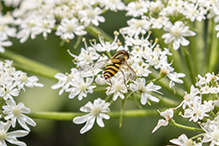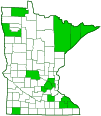yellow-legged flower fly
(Syrphus rectus)
Conservation • Description • Habitat • Ecology • Distribution • Taxonomy
Conservation Status |
|
|||||||
| IUCN Red List | DD - Data Deficient |
|||||||
| NatureServe | NNR - Unranked |
|||||||
| Minnesota | not listed |
|||||||
Description |
||
Yellow-legged flower fly is a common, small to medium-sized, typical hover fly. It occurs in the United States and southern Canada east of the Great Plains. It has also been recorded in western Europe, but the status of this species in Europe is uncertain. These records may represent misidentifications or accidental introductions. Adults are found in deciduous forests, shrublands, and grasslands from late April to mid-November. Biological information on this species is spare. The only floral association recorded for adults is goldenrods (Symphyotrichum spp.). The larvae feed on woolly apple aphids and many other species of aphids. Adults are robust and ¼″ to ⅜″ (7.2 to 10.3 mm) in length. The head is broader than the thorax and hemispherical, not flattened. There are two large compound eyes on the sides of the head and three small simple eyes (ocelli) in a triangle on top of the head. The compound eyes are bare, with no erect hairs. On the male they abruptly converge and meet at the top of the head in front of the ocelli. On the female they do not meet. The upper side of the head (vertex) is black. On the female, the upper part of the face (frons) is shiny black on the upper third. The lower two-thirds is less shiny, black, and densely covered with yellowish-gray hairs. The face is yellow with a vertical brown stripe in the middle. The antennae are short and have three segments. At the base of the third segment there is a long, forward-pointing bristle (arista) on the upper side. The thorax is covered with erect yellow hairs. The large front portion (scutum) is entirely brownish-black with no yellow markings. On each side of the scutum, in the shoulder (humeral) area just behind the head, there is a small plate (postpronotum). The postpronotum is bare, with no hairs or bristles. Unfortunately, this is not visible without first removing the fly’s head. The small rear part of the thorax (scutellum) is yellowish and more or less translucent. There are no bristles on the scutum or scutellum. The abdomen is black with a yellow band on the second through fourth segments (tergites). The first tergite is very narrow. On the second tergite the band is broad and is interrupted in the middle. On the third and fourth tergites the bands are broad and complete, not interrupted, and they are broad, not narrowed, where they meet the lateral margins. The wings are mostly clear. The pigmented region (stigma) near the leading edge of the wing is a diffuse smoky brown patch more than twice as long as wide. There is a false (spurious) vein between the radius (R) and media (M) veins. The basal medial (bm) cell is bare in front and for most of its length. The anal cell is long and is closed near the wing margin. The marginal, R5, and M2 cells are also closed. There are two membranous lobes (calypters) at the base of each wing that cover the balancing structure (haltere). There are long hairs on the upper surface of the lower calypter. This should not be confused with hairs on the edge of the calypter. This feature may require a hand lens or microscope to see. The legs are mostly yellow and brownish-yellow. On the hind legs of the male, the basal two-thirds of the third segment (femur) is dark, and the last part of the leg (tarsus), corresponding to the foot, is entirely dark. On the hind leg of the female, the femur has a dark band near the tip and the tarsus is yellow and dark. |
||
Size |
||
Total length: ¼″ to ⅜″ (7.2 to 10.3 mm) |
||
Similar Species |
||
Habitat |
||
Deciduous forests, shrublands, and grasslands |
||
Ecology |
||
Season |
||
Late April to mid-November |
||
Behavior |
||
|
||
Life Cycle |
||
|
||
Larva Food |
||
Woolly apple aphids and other aphids |
||
Adult Food |
||
Flower nectar and pollen |
||
Distribution |
||||
|
Sources TELFORD, H. S. 1939. The Syrphidae of Minnesota. Univ. of Minn. Agric. Exp. Sta. Tech. Bull. No. 140, 76 pp. |
|||
| 7/5/2023 | ||||
Occurrence |
||||
Common |
||||
Taxonomy |
|||
Order |
Diptera (Flies) | ||
Suborder |
Brachycera | ||
Infraorder |
Cyclorrhapha | ||
| Zoosection | Aschiza | ||
Family |
Syrphidae (Hover Flies) | ||
Subfamily |
Syrphinae (Typical Hover Flies) | ||
Tribe |
Syrphini | ||
Genus |
Syrphus (common flower flies) | ||
Synonyms |
|||
Syrphus transversalis |
|||
Common Names |
|||
yellow-legged flower fly yellow-legged fly |
|||
Glossary
Arista
A large bristle on the upper side of the third segment of the antenna of a fly. Plural: aristae.
Calypter
On flies: one of two small membranous lobes at the base of the forewing that covers the haltere.
Femur
On insects and arachnids, the third, largest, most robust segment of the leg, coming immediately before the tibia. On humans, the thigh bone.
Frons
The upper front part of an insect’s face, roughly corresponding to the forehead.
Halteres
In flies: a pair of knob-like structures on the thorax representing hind wings that are used for balance.
Ocellus
Simple eye; an eye with a single lens. Plural: ocelli.
Scutellum
The exoskeletal plate covering the rearward (posterior) part of the middle segment of the thorax in some insects. In Coleoptera, Hemiptera, and Homoptera, the dorsal, often triangular plate behind the pronotum and between the bases of the front wings. In Diptera, the exoskeletal plate between the abdomen and the thorax.
Scutum
The forward (anterior) portion of the middle segment of the thorax (mesonotum) in insects and some arachnids.
Tarsus
On insects, the last two to five subdivisions of the leg, attached to the tibia; the foot. On spiders, the last segment of the leg. Plural: tarsi.
Tergite
The upper (dorsal), hardened plate on a segment of the thorax or abdomen of an arthropod or myriapod.
Vertex
The upper surface of an insect’s head.
Visitor Photos |
|||||
Share your photo of this insect. |
|||||
| This button not working for you? Simply email us at info@MinnesotaSeasons.com. Attach one or more photos and, if you like, a caption. |
|||||
Greg Watson |
|||||
 |
|||||
MinnesotaSeasons.com Photos |
|||||
|
|||||

Slideshows |
||

Visitor Videos |
|||
Share your video of this insect. |
|||
| This button not working for you? Simply email us at info@MinnesotaSeasons.com. Attach a video, a YouTube link, or a cloud storage link. |
|||
Other Videos |
|||

Created: 7/5/2023
Last Updated:


